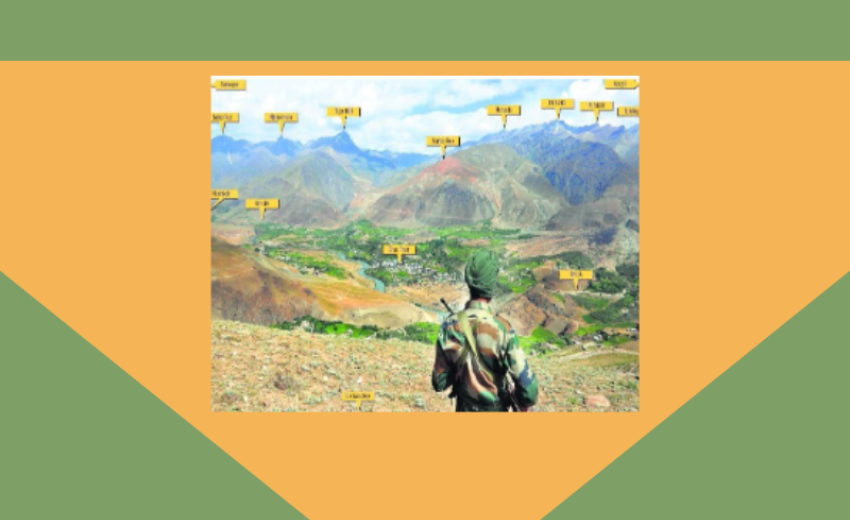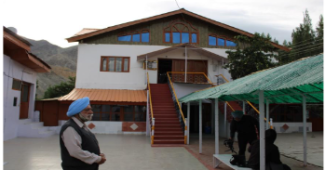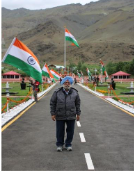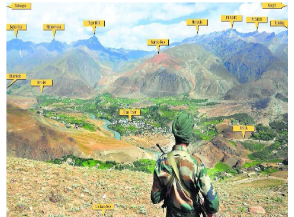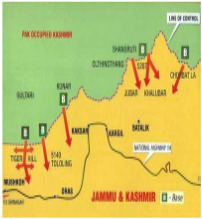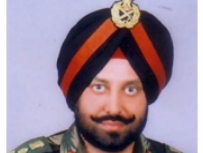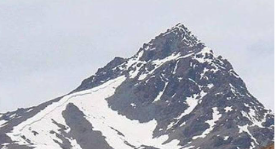Kargil Vijay Diwas is celebrated every year on July 26 to honor the soldiers who fought in the Kargil War. On this day in 1999 India won the Kargil War against Pakistan It drive out the Pakistani troops from their stealthily and secretly occupied positions on the hilltops of the northern Kargil district of Ladakh. On this day Prime Minister of India pays tribute to the soldiers every year at the Amar Jawan Jyoti at India Gate. Events are also organized throughout the country to commemorate the contribution of the Indian Armed Forces, but this year, July 26 is special because it is now 25 years since this war a Silver Jubilee year. It is being celebrated with great fanfare all over India.
Author at Gurdwara Charan Kamal Sahib, Kargil and Kargil Divas Daras
I remember those moments in July 2018 when I reached Kargil from Leh on Kargil Day in search of Guru Nanak Dev ji's footprints. I offered my devotion
to Gurdwara Charan Kamal Sahib in Kargil where Guru Nanak Dev ji had rested his feet. I reached Daras where the Kargil War Memorial is built and in which Kargil Day was being celebrated.
Origin of Kargil War
It was 1988. In Pakistan Brigadier Pervez Musharraf and Prime Minister Benazir Bhutto planned to separate Kashmir from India. The easiest way was found to occupy the hills of the National Highway which runs from Srinagar to Leh. The temperature reaches minus 40 degrees on Kargil Daras and Batalik hills, which would have made it very difficult to get out of through it due to snow cover. Before this, it was a silent agreement between Pakistan and India that the troops would be withdrawn from the hills during the snow season. When Pervez Musharraf became the chief of the army, he implemented the plan and deployed soldiers disguised as jihadis in the Kargil region during the winter season.
The Indian Army was surprised when on May 3, 1999, a shepherd informed about Pakistan troops having entered the Indian border and set up their posts there. On May 5, the Indian Army sent a five-man patrol with Captain Sourav Kalia to see if what was said was true. When the patrol did not come back, the images of the area were searched by airplanes and helicopters. It was found that Pakistan had built a large number of bunkers on Kargil, Daras and Batalik hills. India then gathered 30 battalions to that area so that these intruders could be chased away from here. Eight Sikh Battalion was a very important part of these troops.
This area of Kargil is located on the main road from Srinagar to Leh in the northern part of Kashmir and is a hilly area generally covered with snow in winter. On 26 July 1999, India badly defeated the soldiers sent by the Pakistanis in the guise of civilian jehadis and forced them to lay down their weapons.
Kargil area The main intention of the Pakistanis was to take possession of the main hills, Tiger Hill, Tololing, etc., along this highway that passes through Mushkoh, Daras, Kaksar, Kargil, Batalik and joins Leh, and then keep an eye on this road, shelling the incoming convoy. Main aim was to cut off Leh from the Kashmir Valley by blocking this route. Pakistan used its soldiers to infiltrate into the terror valleys in May 1999 and then built bunkers on these hills. By the time the Indian Army came to know of this movement, the Pakistanis had firmly established themselves on these hills. Indian forces drummed them heavily against all odds and killed many of them in mostly hand to hand battles at the tops. Most of the Pakistanis were killed but those who survived were surrounded but were allowed to leave with the mediation of America. This nefarious move of Pakistan was thus foiled, and the battlefield fell into the hands of India.
121 Independent Brigades of 15 Corps of Northern Command, 56 and 79 Mountain Brigades and 50 Independent Para Brigades of 8 Mountain Division and 70 Infantry Brigades and 102 Independent Infantry Brigades of 3 Infantry Division took part in this war. There were also two brigades of artillery.
Among the three Sikh regiments of Punjab, 8 and 11 Sikh Regiment and 14 Sikh LI Regiment and two Punjab Regiments 3 Punjab and 13 Punjab also advanced and contributed to trample the enemy badly. Sikh, Sikh LI and Punjab Regiments of India have been honoured with the highest number of war awards.
Bravery is another name of Sikh regiment. It has a long and distinguished history. It remains the most highly decorated regiment in the Indian Army with 73 war honours and 38 theatr honours. Before independence it received 14 Victoria Crosses, 21 Indian Orders of Merit (equivalent to Param Vir Chakra) and many other coveted awards. Most decorated was 1 Sikh hero Nand Singh who had a Victoria Cross on his chest before independence and a Mahavir Chakra after independence. In addition, the regiment has, in the post-independence era, won two Paramveer Chakras, two Ashoka Chakras, two Param Vishishta Seva Medals, 14 Mahaveer Chakras, 4 Ashoka Chakras, 5 Kirti Chakras, 64 Veer Chakras, one Uttam Yudh Seva Medal, in addition to numerous other medals.
The Sikh LI Regiment received one Ashoka Chakra, 5 Mahavir Chakras, 6 Kirti Chakras, 23 Veer Chakras, 13 Shauria Chakras and over 300 other awards. The Punjab Regiment received 21 Victoria Cross, 187 Military Cross, 2 Padma Bhushan, 1 Padma Shri, 18 Maha Veer Chakra, 18 King's Cross, 20 PVSM, Veer Chakra 69 and over 500 other honours. Three Sikh Units including 3 Punjab and 3 Medium regiment were among those who taught China a lesson in Galwan Valley, Gurtej Singh of 3 Punjab single-handedly killed 12 Chinese and set an example and was awarded the Vir Chakra.
In 1999 two brigades were brought forward to protect the Kargil region. Brigadier MPS Bajwa was commanding 192 Infantry Brigade and Brigadier Devinder Singh was commanding 70 Infantry Brigade. Both were Sikh officers. 3 Infantry Division was commanded by Major General Mohinder Puri who was a Punjabi. Chief of Army Staff General Malik was also a Punjabi. The most difficult target for Brigadier Bajwa was to clear Tiger Hill from enemies.
Brigadier MPS Bajwa He was given two battalions of 8 Sikhs and 18 Grenadiers for the attack on Tiger Hill. According to Brigadier Bajwa's writing, 'I chose the most difficult route for the attack on Tiger Hill, the direct ascent... 8 Sikhs were put forward for this most difficult task and I told the commanding officer that it was a question of the honour of the Sikhs. We selected 52 men, including two officers and two subedars and 48 Jawans. These 52 brave men fought so bravely that they changed the map of the war. Artillery especially Bofors (Artillery Brigade was also commanded by a Sikh Brigadier) helped us a lot in this difficult time because our men were under direct fire of enemy rifle, LMG and MMG. The young men showed great lionheartedness and reached that peak by constantly advancing in the pouring rain of bombs and bullets.
Tiger Hill The enemy retaliated on them due to which 14 soldiers were martyred and many were injured. Two officers were injured and both subedars were martyred. Brigadier Bajwa wrote that 'when the Pakistani counterattack was taking place, 8 Sikh subedar told me that a very tall Pakistani was constantly inciting his men to attack again, due to which it was difficult to stay at the height. I told him that this officer should be eliminated so that the counterattacks are stalled. I say with certainty that their counterattacks were so strong that our Sikh warriors could have been knocked off the top at any time. But our warriors shouted ‘Bole So Nihal’ a Sikh slogan so loudly that the enemy was shaken up and their counterattacks were broken. First of all, we killed that Pakistani officer and then chased the others who left the field empty for us. The name of that Pakistani officer was Captain Colonel Sher Khan. "30 Pakistanis were killed in this battle and the rest retreated giving us a famous victory. Captain Colonel Sher Khan rallied his men and fought very well," said Brigadier Bajwa. “I reported to the GOC about the bravery of him and my Sikh warriors. Seeing more attacks happening, I encouraged them regularly.
The names of the martyrs of Punjab in the Kargil war are as follows:
8 Sikhs-Subedar Karnail Singh-Vir Chakra, Naik Ranjit Singh-Sena Medal, Subedar Joginder Singh-Sena Medal, Naik Bahadur Singh-Sena Medal; Sepoy Major Singh-Sena Medal, Havildar Desa Singh, Havildar Amar Singh, Naik Nirmal Singh, Naik Baldev Singh, Havildar Vikram Singh, Sepoy Kulwinder Singh, Sepoy Tarlochan Singh, Sepoy Darshan Singh, Sepoy Surjit Singh, Sepoy Jaswinder Singh, Sepoy Gurmail Singh , Sepoy Jeevan Singh, Sepoy Rashwinder Singh, Sepoy Sukhwinder Singh, Sepoy Sukhwinder Singh second. 14 Sikh-Sepoy Buta Singh.
Punjabi Martyrs of Other Platoons: Majors: Harminder Pal Singh, JDS Dhaliwal, KG Singh; Subedars: Naunihal Singh Bhullar, Kuldeep Singh, Sucha Singh, Daljit Singh; Naib Subedar Kamil Singh; Havildar Kamaldev Singh, Tarsem Singh, Gurmeet Singh, Amarjit Singh, Gurmeet Singh, Karam Singh, Gian Singh; Lance Havildar Baldev Singh, Naik Puran Singh, Sucha Singh, Paramjit Singh, Sikandar Singh; Lance Naik- Balwinder Singh, Rajinder Singh, Dalveer Singh, Gurmail Singh, Amarjit Singh, Gurcharan Singh, Kuldeep Singh, Ranbir Singh; Sepoy Gurmej Singh, Pawan Singh, Jaskaran Singh, Darshan Singh, Jaswant Singh, Gurmail Singh, Daljit Singh; PTA Harvinder Singh, Gopal Singh, Grenadier Gurinder Singh, Gurpreet Singh, Avtar Singh and others.
Other Sikhs and Punjabi also did very commendable job but due to space restriction only sample details are given.

